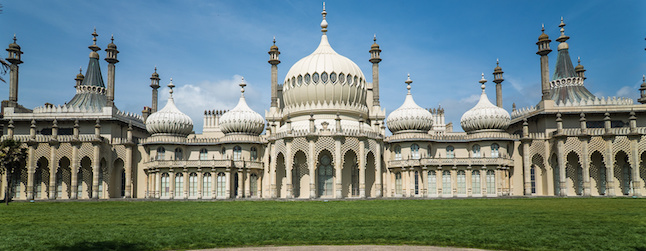Discover: The Royal Pavilion
In the centre of Brighton is an instantly recognisable building that would look more at home in India than by the Sussex coast. An architectural marvel of white arches and pillars with a centrepiece comprised of four enormous domes, The Royal Pavilion is an extravagant palace inspired by oriental design. As impressive as the exterior is, it has nothing on the vibrant interior design that takes you even further into oriental escapism and fantasy. Originally built as the seaside pleasure palace for the Prince Regent George, it has had a fascinating history, having been used as both a civic building and a hospital in the First World War.
By Charlie Walker | Updated Feb 24 2022

Rome wasn’t built in a day, and neither was the Royal Pavilion. The beginnings of this iconic building were actually considerably more modest than one might now assume. The site of the Royal Pavilion started out, perhaps unbelievably, as a modestly-sized farmhouse. Prince George bought the property in 1787, an attempt to soothe his recurring glandular problems with the sea air’s therapeutic properties. He asked architect Henry Holland to transform the building into the Marine Pavilion, the result a considerably smaller but largely recognisable structure to today. When George became the Prince Regent, he commissioned a further architect John Nash to revamp the building with no expense spared, and so the pavilion we know now was born.

The Royal Pavilion's Banquet Room. Photo Credit: Herry Lawford
Wandering through the Royal Pavilion, the extravagance of the design blows one away. The exterior has similarities to the Mughal architecture of The Taj Mahal, whilst the interior is perhaps the most prominent example of the chinoiserie (inspired by Chinese design and motifs) style in England. The Prince Regent never visited Asia. The Pavilion’s architecture embodied the Empire’s perpetual fascination with the East, a fantastical amalgamation of different elements of Asian culture thrust together in an eclectic vision. Take a stroll past the pink walls of The Long Gallery, with its gold detailing and intricate Chinese illustrations, and you can see the this fantasy embodied. It was meant to replicate a bamboo grove with iron casts imitating the shape of bamboo stalks.
Next you find the grandiose marvel of the Banquet room, with its velvet red drapes, enormous central table and a chandelier held in the claws of a dragon. Every room in the Royal Pavilion was designed to evoke a different atmosphere. Noticeably contrasting from the rich opulence of the Banquet Room is the calmer adjoining gallery designed for guests to relax in after dinner. Its subdued greens and golden pillars support a floor that resemble palm trees from a faraway land. Even the servants’ kitchen were constructed to appear to have tropical foliage, neatly fitted between the most advanced technology available in the 1800s - ventilation and state-of-the-art steaming system.

Royal Pavilion interiors. Photo Credit: Herry Lawford
Eighteen years after King George’s death in 1849, parliament passed a bill to demolish the Royal Pavilion. Before this could happen, however, the town bought the building for £53,000. Since then, the local heirloom has been subject to an ongoing project of conservation. Under town ownership the Pavilion became a civic hub for Brighton, acting as a library and even a flea circus: it was a multi-purpose space for an ever-developing town. It’s most important function arguably came between 1914 and 1920, when its rooms were converted to a hospital for Indian soldiers and World War One amputees. 2,300 Indian soldiers were cared for in the Pavilion during this period.
Now, the Pavilion is one of Brighton’s must-see tourist hubs. Some of the additions to the building have become central to Brighton’s vibrant arts and culture scene. Brighton Museum, opened in 1861, uses the former cavalry barracks of the pavilion; and the performing arts venue The Brighton Dome now occupies the former stables. A visit to the Royal Pavilion gives an unparalleled insight into Western culture’s long-standing love affair with Asian design. This is an exceptional conservation project with truly grand and lavish interiors that seem thousands of miles away from your typical stately home or palace.
Visit the Royal Pavillion at 4/5 Pavilion Buildings, Brighton BN1 1EE. Adult admission is £12.30 and £6.90 for children. Find out more on the Brighton Pavilion website.